
Oneida County is a county in the state of Wisconsin, United States. At the 2020 census, the population was 37,845. Its county seat is Rhinelander.
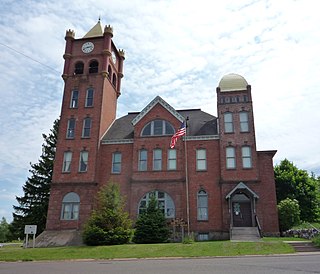
Iron County is a county located in the U.S. state of Wisconsin. As of the 2020 census, the population was 6,137, making it the third-least populous county in Wisconsin. Its county seat is Hurley. It was named for the valuable iron ore found within its borders. The county overlaps with small parts of the Bad River and Lac du Flambeau Indian reservations.
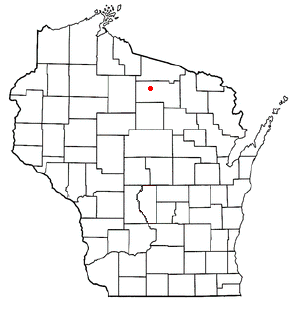
Hazelhurst is a town in Oneida County, Wisconsin, United States. The population was 1,258 at the 2018 census. The unincorporated community of Hazelhurst is located in the town.

Rhinelander is a city in and the county seat of Oneida County, Wisconsin, United States. The population was 8,285 at the 2020 census.

In American folklore, the hodag is a fearsome critter resembling a large bull-horned carnivore with a row of thick curved spines down its back. The hodag was said to be born from the ashes of cremated oxen, as the incarnation of the accumulation of abuse the animals had suffered at the hands of their masters. The history of the hodag is strongly tied to Rhinelander, Wisconsin, where it was claimed to have been discovered. The hodag has figured prominently in early Paul Bunyan stories.

Ashland is a city in Ashland and Bayfield counties in the U.S. state of Wisconsin. It is the county seat of Ashland County. The city is a port on Lake Superior, near the head of Chequamegon Bay. The population was 7,908 at the 2020 census, all of whom resided in the Ashland County portion of the city. The unpopulated Bayfield County portion is in the city's southwest, bordered by the easternmost part of the Town of Eileen.
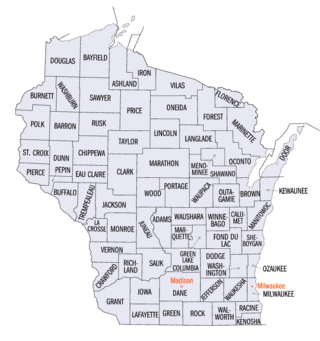
This is a list of properties and districts listed on the National Register of Historic Places in Wisconsin. There are over 2,500 listed sites in Wisconsin. Each of the state's 72 counties has at least one listing on the National Register.
Purcell & Elmslie (P&E) was the most widely known iteration of a progressive American architectural practice. P&E was the second most commissioned firm of the Prairie School, after Frank Lloyd Wright. The firm in all iterations was active from 1907 to 1921, with their most famous work being done between 1913 and 1921.

Rhinelander High School (RHS) is a high school in Rhinelander, Oneida County, Wisconsin, United States.

The First National Bank of Mankato, also known as the Old First National Bank of Mankato and located at 229 South Front Street in Mankato, Minnesota, United States, is a fine example of Prairie School architecture in a commercial building, relating rural life to the development of downtown Mankato as a regional center of commerce and finance. The recently restored exterior is now part of the Mankato Civic Center, the Mayo Clinic Health System Event Center.
WXPR is a community-licensed public radio station serving north central Wisconsin and adjacent areas of Michigan's Upper Peninsula. Licensed to Rhinelander, Wisconsin, United States, the station is owned by White Pine Community Broadcasting, a nonprofit educational corporation. WXPR is a National Public Radio member station as well as an affiliate of Native Voice One. The studios are at 28 N. Stevens St. in downtown Rhinelander, in a historic building previously occupied by the local newspaper. The transmitter is off Oneida County Highway A between Sugar Camp and Three Lakes, Wisconsin, southwest of Thunder Lake.

The Farmers and Merchants Union Bank is a historic commercial building at 159 West James Street in Columbus, Wisconsin. Built in 1919, it is the last of eight "jewel box" bank buildings designed by Louis Sullivan, and the next to last to be constructed. It was declared a National Historic Landmark in 1976 for its architecture.
First National Bank Building, or variants thereof, may refer to:
The 12th Senate District of Wisconsin is one of 33 districts in the Wisconsin Senate. Located in northern Wisconsin, the district comprises Florence, Forest, Langlade, Lincoln, Marinette, Oneida, and Vilas counties, and parts of northern Oconto County, northwest Shawano County, and northeast Marathon County. It contains the cities of Antigo, Eagle River, Marinette, Merrill, Peshtigo, Rhinelander, and Tomahawk.
Jennings is an unincorporated community located in the town of Schoepke, Oneida County, Wisconsin, United States. Jennings is located at the junction of County Highways B and Z 19 miles (31 km) east-southeast of Rhinelander. Mecikalski General Store, Saloon, and Boarding House, which is listed on the National Register of Historic Places, is located in Jennings.
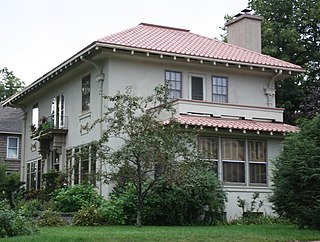
The Solon and Mathilda Sutliff House is a historic house located at 306 Dahl Street in Rhinelander, Wisconsin. It was added to the National Register of Historic Places on October 7, 2009.
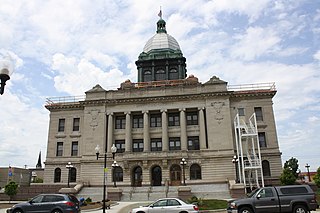
Christian H. Tegen, often known as Christ H. Tegen, was a German-born American architect. He was regarded as a "renowned" architect.
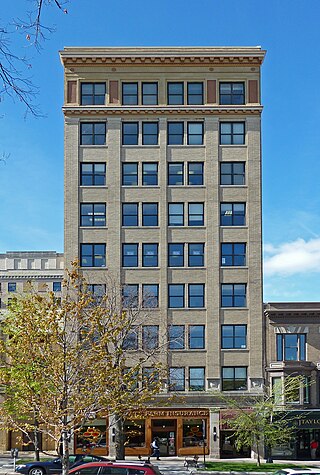
Law, Law & Potter was an architecture firm in Madison, Wisconsin; Potter Lawson, Inc. is its modern-day successor. Some of its buildings are listed on the U.S. National Register of Historic Places for their architecture. The firm was Madison's largest and "arguably most important" architectural firm in the 1920s and 1930s.

The Oneida County Courthouse is a three-story, copper-domed county courthouse located in Rhinelander, Wisconsin. It houses the circuit court and government offices of Oneida County, Wisconsin. The building was listed on the National Register of Historic Places in 1981 and on the State Register of Historic Places in 1989 for its significance as a local example of Neoclassical architecture.

The Farmers and Mechanics Bank is a historic building in the Georgetown neighborhood of Washington, D.C. Constructed between 1921 and 1922, the bank was first the headquarters of the Farmers and Mechanics National Bank. Soon thereafter, it became known as the Farmers and Mechanics Branch of Riggs National Bank. In 2005, the building became a branch of PNC bank.


















